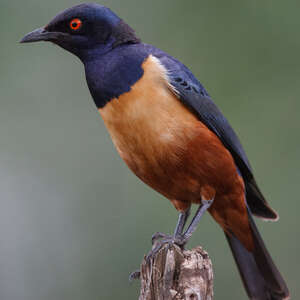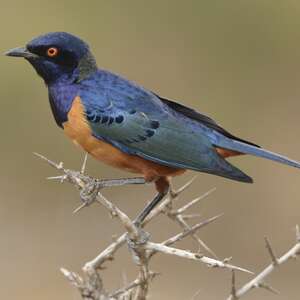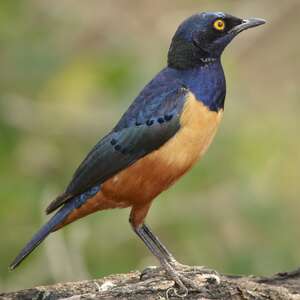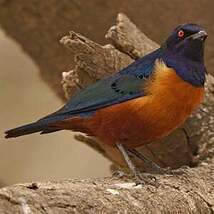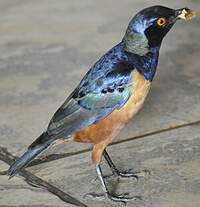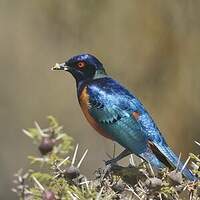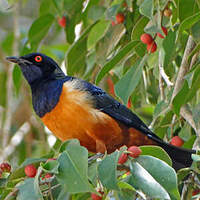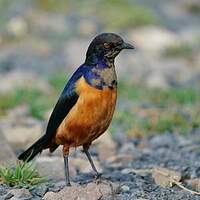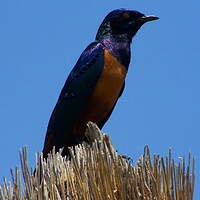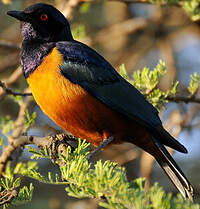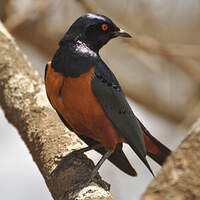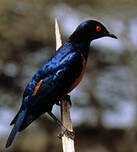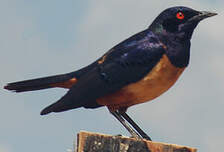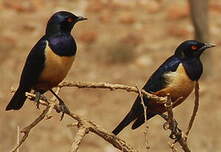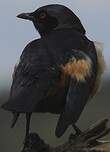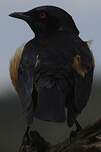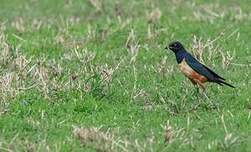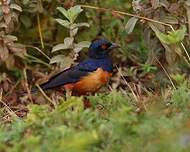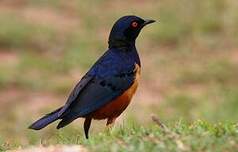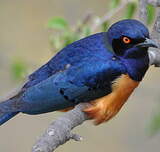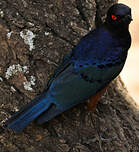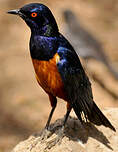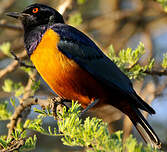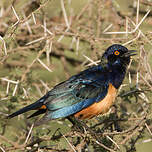Hildebrandt's Starling
Lamprotornis hildebrandti - Choucador de Hildebrandt
Identification
If it weren't for the orange-red iris instead of white and the absence of a white pectoral band, the novice could confuse Hildebrandt's Starling with the more common Superb Starling and with which it can share the habitat. For a knowledgeable public, the range of colors that Hildebrandt's Starling has is less bright and the differences between each colored part of the body are less evident. No sexual dimorphism is present in this species. A wide black stripe that looks like a mask starts from the base of the beak and goes down to the parotic. The rest of the head: chin, throat, chest and crown are metallic blue with purple / violet reflections. In the back, the nape is a very dark green-bronze. The mantle is metallic blue resembling the color of the crown and the wings are green-bronze recalling the color of the nape. The tips of the primary remiges are iridescent blue as well as the rectrices. Each small and medium cover ends with a small rounded blue / navy to black spot that from afar appears only as a point. The chest, sides and belly are entirely orange. The legs and beak are black.
Subspecific information monotypic species
Foreign names
- Choucador de Hildebrandt,
- Estornino de Hildebrant,
- estorninho-dos-massais,
- Hildebrandtglanzstar,
- Hildebrandt-fényseregély,
- Hildebrandts Glansspreeuw,
- Storno di Hildebrandt,
- hildebrandtglansstare,
- Masaistær,
- liskavec červenooký,
- leskoptev Hildebrandtova,
- Masaiglansstær,
- keniankottarainen,
- estornell de Hildebrandt,
- błyszczak półobrożny,
- Спрео Гильдебранта,
- チャバラテリムク,
- 希氏丽椋鸟,
- 希德氏麗椋鳥,
Voice song and cries
Habitat
Behaviour character trait
Hildebrandt's Starling lives in small groups or pairs often close to livestock. It uses the movement of large herds, among which it hops more than it walks, to consume insects disturbed on the ground. It can also hunt them in flight and does not hesitate to mix with groups of other species of the same family.
Dietfeeding habits
Reproduction nesting
The breeding period of Hildebrandt's Starling stretches from March to May or October to December. However, in Kenya it seems that the period from May to July is somewhat favored.
Like its close cousin the Superb Starling, Hildebrandt's Starling breeds in pairs, sometimes with the cooperation of other males. This cave-dwelling species uses old woodpecker holes which also attract the Blue-eared Starling. These two species are then in competition during breeding for a free cavity. Occasionally, it may nest in electric pole holes. In the nest made of vegetable fibers, the female lays 3-4 eggs. The chicks are fed by the two adults. The cuckoo-shrike is known to parasitise the nest of Hildebrandt's Starling.Threats - protection
Sources of information
- IOC World Bird List (v14.1), Gill, F and D Donsker (Eds). 2024-04-18.
- Birds of Kenya and Northern Tanzania, Dale A Zimmerman, Donald A Turner, David J Pearson
- BirdLife International, BirdLife International
- Wikipedia (English version),
Other sources of interest
 Specification sheet created on
24/07/2023 by Nathalie Santa Maria
Specification sheet created on
24/07/2023 by Nathalie Santa MariaTranslation by AI Oiseaux.net
published: 23-06-2016 - Updated: 11-09-2016
© 1996-2024 Oiseaux.net
- Accipitriformes
- Aegotheliformes
- Anseriformes
- Apodiformes
- Apterygiformes
- Bucerotiformes
- Caprimulgiformes
- Cariamiformes
- Casuariiformes
- Charadriiformes
- Ciconiiformes
- Coliiformes
- Columbiformes
- Coraciiformes
- Cuculiformes
- Eurypygiformes
- Falconiformes
- Galliformes
- Gaviiformes
- Gruiformes
- Leptosomiformes
- Mesitornithiformes
- Musophagiformes
- Nyctibiiformes
- Opisthocomiformes
- Otidiformes
- Passeriformes
- Pelecaniformes
- Phaethontiformes
- Phoenicopteriformes
- Piciformes
- Podargiformes
- Podicipediformes
- Procellariiformes
- Psittaciformes
- Pterocliformes
- Rheiformes
- Sphenisciformes
- Steatornithiformes
- Strigiformes
- Struthioniformes
- Suliformes
- Tinamiformes
- Trogoniformes

